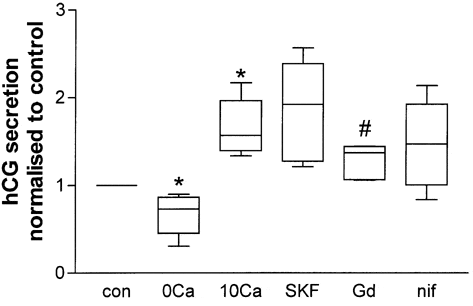Human chorionic gonadotrophin (hCG) secretion by the syncytiotrophoblast of the human placenta is essential for a successful pregnancy. It has previously been demonstrated that extracellular Ca2+ is necessary for hCG secretion (Sharma & Rao, 1997) and entry of Ca2+ via L-type Ca2+ channels has been implicated in this process (Sharma & Rao, 1997; Cemerik et al. 1998). However, direct studies have failed to identify L-type Ca2+ channels in human placental trophoblast cells (Bax et al. 1994; Cronier et al. 1999). Therefore the entry pathway for Ca2+ is not clear. The aim of this study was to examine the effect of a range of Ca2+-permeable channel blockers on hCG secretion from human placental villous fragments.
With ethical approval, villous fragments of approximately 3-5 mg wet weight were dissected from term human placentas. Fragments were washed in control Tyrode solution (mM: NaCl 135, KCl 5, MgCl2 1, CaCl2 1.8, glucose 5.6, Hepes 10; pH 7.4 with NaOH), then incubated (six per vial) for 1 h in Ca2+-free (0 mM CaCl2 + 0.5 mM EGTA), control Tyrode buffer or buffer containing 10 mM CaCl2 in the presence and absence of three Ca2+-permeable channel blockers. The blockers examined were: 50 µM SKF96365 (blocks store-operated Ca2+ channels), 150 µM GdCl3 (a blocker of Ca2+ entry pathways including non-selective cation channels), 1 µM nifedipine (blocks L-type Ca2+ channels). Following incubation hCG secretion was assessed by assay and placental fragment blotted wet weight was determined. Data were calculated as mIU ml-1 mg-1 wet weight, then normalised to the control hCG secretion to account for interplacental variability.
hCG secretion in Ca2+-free buffer was significantly reduced compared with control, whereas there was a significant increase in hCG secretion following exposure to 10 mM CaCl2 (Fig. 1). hCG secretion stimulated by 10 mM CaCl2 was significantly reduced in the presence of 150 µM GdCl3; nifedipine and SKF6936 were without effect (see Fig. 1).
We have confirmed that hCG secretion by human term placenta is dependent on extracellular Ca2+. The data suggest that L-type Ca2+ channels are not involved in regulation of hCG secretion. Conversely the effect of GdCl3 suggests that extracellular Ca2+ entry via Ca2+-permeable non-selective cation channels may be important in this process.
This work was supported by the MRC.
 View larger image [new window] |
| Figure 1. Graph showing normalised data for hCG secretion from term placental villous fragments. Values are medians ± range, n = 6. *P < 0.05 vs. control; #P < 0.05 vs. 10 mM Ca2+ (Kruskal-Wallis with Dunn’s multicomparisons test). con, control; 0Ca, Ca2+-free buffer; 10Ca, 10 mM Ca2+ buffer; SKF, 50 µM SKF96365; Gd, 150 µM GdCl3; nif, 1 µM nifedipine (all channel blockers were in 10 mM Ca2+ buffer). |

